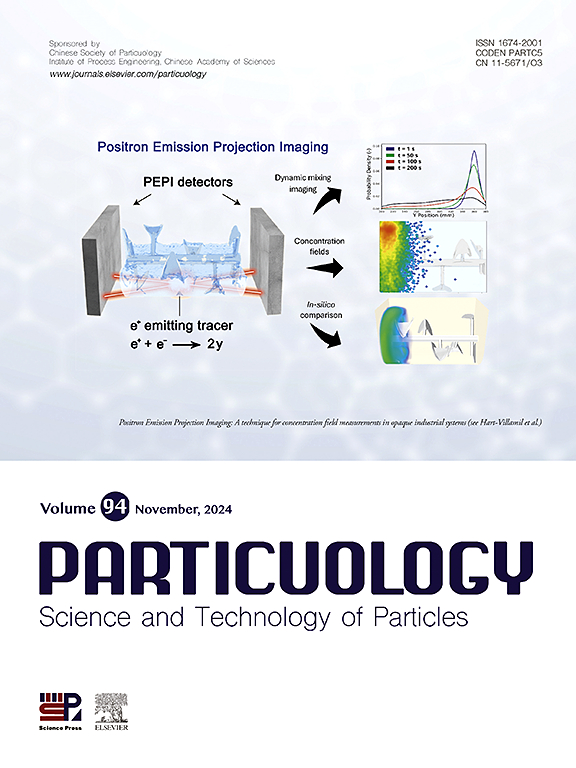涂覆黑碳吸湿生长过程中的光学和辐射特性及单粒子烟尘光度计混合态反演误差
IF 4.1
2区 材料科学
Q2 ENGINEERING, CHEMICAL
引用次数: 0
摘要
在不同含水量环境下,涂层黑碳(BC)气溶胶的混合状态和粒径的变化会引起光学和辐射效应的变化。本研究建立了六种相对湿度(RHs = 0-95%)下薄层、部分和厚层BC的分形模型,并在1064和532 nm处进行了光学模拟。选取差分散射截面反演BC的混合状态(Dp/Dc),探讨单粒子烟尘光度计(SP2)非球形形貌可能导致的反演误差。此外,还分析了不同RHs下BC气溶胶的辐射强迫。结果表明,对于BC体积分数小于0.10的包覆颗粒,其Dp/Dc的反演误差(REs)为负值,说明包覆分形BC在吸湿生长过程中被低估了混合状态。从平均res来看,部分包覆模式对混合状态的反演精度最好,其次是闭室模式和包覆集合体模式。不同BC体积分数的部分包覆气溶胶的辐射强迫增强呈指数递增,呈现相反的增温或降温效应。该研究有助于理解SP2反演的BC省气溶胶Dp/Dc的不确定性及其在不同RHs下的辐射强迫。本文章由计算机程序翻译,如有差异,请以英文原文为准。

Optical and radiative properties of coated black carbon during hygroscopic growth and retrieval errors of mixing state using single-particle soot photometer
Under environment with various water contents, the variations in the mixing state and particle size of coated black carbon (BC) aerosols cause changes in optical and radiative effects. In this study, fractal models for thinly, partially, and thickly coated BC under six relative humidities (RHs = 0–95%) are constructed and optically simulated at 1064 and 532 nm. Differential scattering cross-sections are selected to retrieve the mixing state (Dp/Dc) of BC to investigate the possible retrieval errors caused by the nonspherical morphology when using the single-particle soot photometer (SP2). Furthermore, the radiative forcing of BC aerosols at different RHs are analyzed. Results showed that the retrieval errors (REs) of Dp/Dc are negative for coated particles with BC volume fraction smaller than 0.10, indicating that the mixing states of coated fractal BC are underestimated during the hygroscopic growth. The partially-coated BC has the best retrieval accuracy of the mixing state, followed by the closed-cell and coated-aggregate model, judging from averaged REs. Radiative forcing enhancements for partially-coated aerosols with different BC volume fractions exponentially increase to opposite values, resulting in a warming or cooling effect. This study helps understand the uncertainties in Dp/Dc of BC aerosols retrieved by SP2 and their radiative forcing at different RHs.
求助全文
通过发布文献求助,成功后即可免费获取论文全文。
去求助
来源期刊

Particuology
工程技术-材料科学:综合
CiteScore
6.70
自引率
2.90%
发文量
1730
审稿时长
32 days
期刊介绍:
The word ‘particuology’ was coined to parallel the discipline for the science and technology of particles.
Particuology is an interdisciplinary journal that publishes frontier research articles and critical reviews on the discovery, formulation and engineering of particulate materials, processes and systems. It especially welcomes contributions utilising advanced theoretical, modelling and measurement methods to enable the discovery and creation of new particulate materials, and the manufacturing of functional particulate-based products, such as sensors.
Papers are handled by Thematic Editors who oversee contributions from specific subject fields. These fields are classified into: Particle Synthesis and Modification; Particle Characterization and Measurement; Granular Systems and Bulk Solids Technology; Fluidization and Particle-Fluid Systems; Aerosols; and Applications of Particle Technology.
Key topics concerning the creation and processing of particulates include:
-Modelling and simulation of particle formation, collective behaviour of particles and systems for particle production over a broad spectrum of length scales
-Mining of experimental data for particle synthesis and surface properties to facilitate the creation of new materials and processes
-Particle design and preparation including controlled response and sensing functionalities in formation, delivery systems and biological systems, etc.
-Experimental and computational methods for visualization and analysis of particulate system.
These topics are broadly relevant to the production of materials, pharmaceuticals and food, and to the conversion of energy resources to fuels and protection of the environment.
 求助内容:
求助内容: 应助结果提醒方式:
应助结果提醒方式:


